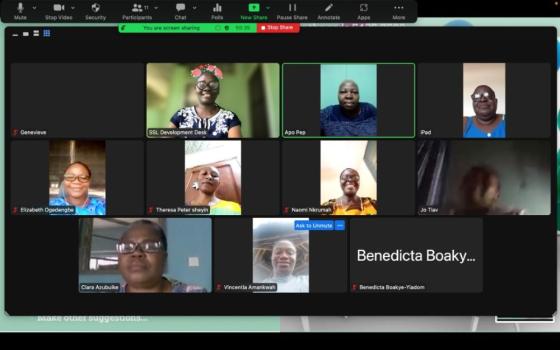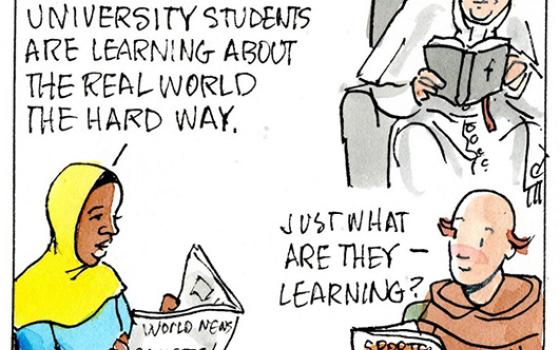CATHOLICISM: A JOURNEY TO THE HEART OF THE FAITH
By Robert Barron
Published by Image Books, $27
There is much to admire in Fr. Robert Barron’s latest book, Catholicism, a companion to his 10-part video series of the same name aired nationally on a select number of television stations. Its limitations also help to point out the serious challenges facing the church’s missionary outreach to billions of people outside the church and to the millions of Catholics who have left.
Barron, a professor of theology at Mundelein Seminary in Illinois and the founder of “Word on Fire” media ministries, has been praised as “one of the church’s best messengers” by Chicago Cardinal Francis George, a major patron of Barron’s role in what is being called the “new evangelization.”
Barron has emerged in the past decade as a prodigious author and media presence reminiscent of the iconic “television priest” of the 1950s, Archbishop Fulton J. Sheen. Still boyish at 50 in black suit and collar, Barron employs a rhetorical repertoire ranging from classical arguments for the existence of God to baseball analogies for papal infallibility (the pope as umpire) to distill complex religious questions into Catholic talking points. In Catholicism, Barron repackages “the church at its best” into a familiar catechism on the Trinity, Incarnation, Mary, the church, the Mass, the communion of saints, prayer and the last things.
 The Roman Catholic church, Barron argues, represents God to the world because of the doctrine of the Incarnation. Because Jesus is God, the church has a divine mandate. Using the high Christology of John’s Gospel and a literal acceptance of the words and miracles recorded by the other evangelists, Barron presents Jesus as divinely self-aware, a veritable Yahweh striding into human history to fulfill the law and the prophets, dying on the cross to defeat both Satan and all earthly empires, rising from the dead to validate his divine identity, and entrusting his mission to Peter and the apostles. In a seamless trajectory that survives persecution, heresy, imperial appropriation under Constantine, papal corruption, East-West division, the Protestant Reformation, the Enlightenment and the rise of modern secularism, Jesus’ mandate now resides in the Catholic church as the mystical body of Christ in the world.
The Roman Catholic church, Barron argues, represents God to the world because of the doctrine of the Incarnation. Because Jesus is God, the church has a divine mandate. Using the high Christology of John’s Gospel and a literal acceptance of the words and miracles recorded by the other evangelists, Barron presents Jesus as divinely self-aware, a veritable Yahweh striding into human history to fulfill the law and the prophets, dying on the cross to defeat both Satan and all earthly empires, rising from the dead to validate his divine identity, and entrusting his mission to Peter and the apostles. In a seamless trajectory that survives persecution, heresy, imperial appropriation under Constantine, papal corruption, East-West division, the Protestant Reformation, the Enlightenment and the rise of modern secularism, Jesus’ mandate now resides in the Catholic church as the mystical body of Christ in the world.
While such exclusive claims are not likely to win over non-Christians, non-Catholics, or unchurched or lapsed Catholics, the book and DVD series have cheered insiders who share Barron’s triumphant vision and his view that the church has been unfairly treated over recent public scandals and controversies. Barron argues that, whatever its human failures, the church’s divine mandate guarantees its authenticity and that if further witness is needed, the truth, beauty and holiness of the church’s scholars, saints, shrines, art and music demonstrate it.
If this arguably romantic view of the church strikes skeptics as selective and nostalgic, Barron’s approach nevertheless serves to identify the context and nature of the campaign known as the new evangelization.
What is the new evangelization?
In his 1990 encyclical Redemptoris Missio, the late Pope John Paul II first distinguished the church’s external mission to preach the Gospel to the nations from a more internal effort to reach nominal Catholics who have not responded to the Gospel. As the idea of an internal evangelization has taken hold under Pope Benedict XVI, some proponents have also welcomed it as a pushback to dissident Catholics, while critics have seen it as misdirection, or what NCR’s John Allen described as “an ‘exit strategy’ from the various crises and internal conflicts that have recently marred Catholic life.”
Whatever the popes intended, an inner-directed evangelization in the current unsettled state within the church risks being seen as a way to characterize liberal Catholics who want the renewal and reform of the church promised by the Second Vatican Council as disloyal and even lacking in faith.
Barron’s book and series, valuable on their own terms as an evocation of the historical treasures of Catholic thought and culture, also appear to function as in-house apologetics for the restorationist agenda of some bishops and a Vatican establishment intent on circling the wagons even at the cost of effective outreach. As re-education directed at the wayward, Barron answers questions most Vatican II reformers are not asking. Like the council itself, they are not challenging doctrine, only asking for a more pastoral, open and accountable institutional church.
Barron’s approach does not escape the irony of John Paul’s call for renewed evangelization at the same time he was narrowing the chances for productive dialogue with other Christians and other world religions by asserting Catholic authority over the outcome. What seems evident to insiders appears arrogant to everyone else.
Barron is eloquent, but his new evangelization still sounds like old apologetics for a Catholicism that is too boxed in by certitude to risk genuine interfaith cooperation. His generous effort produces a version of the church too small and sectarian to the meet the current challenge. At a time when the world is spinning out of control, what all religions really need is deeper faith in the freedom of God to do something new.
[Pat Marrin is editor of Celebration, NCR’s worship resource. Contact him at patmarrin@aol.com.]








